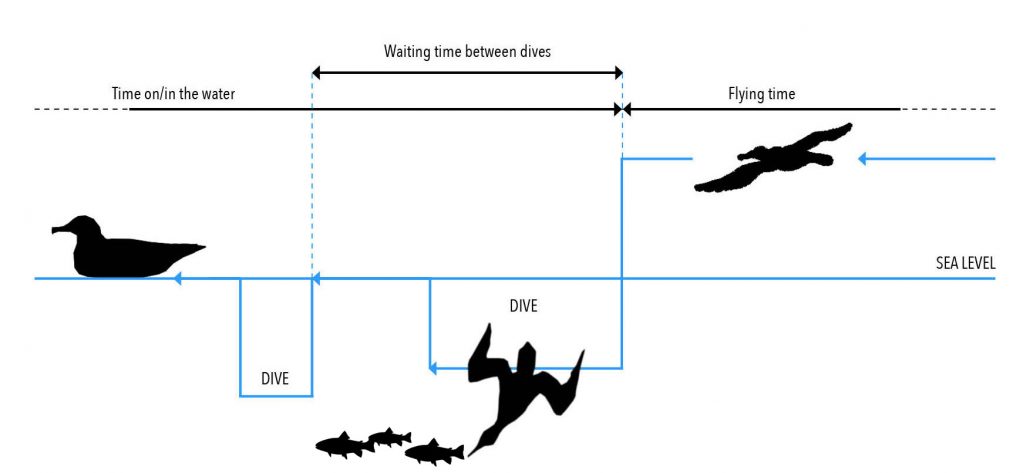MOVEMENT ECOLOGY OF SEABIRDS: a mechanistic explanation of their incredible navigation ability
LÉVY FLIGHT |
AVIAN
|
EXPERIMENTS |
RESULTS |
THE TEAM |
LÉVY 2.0 |
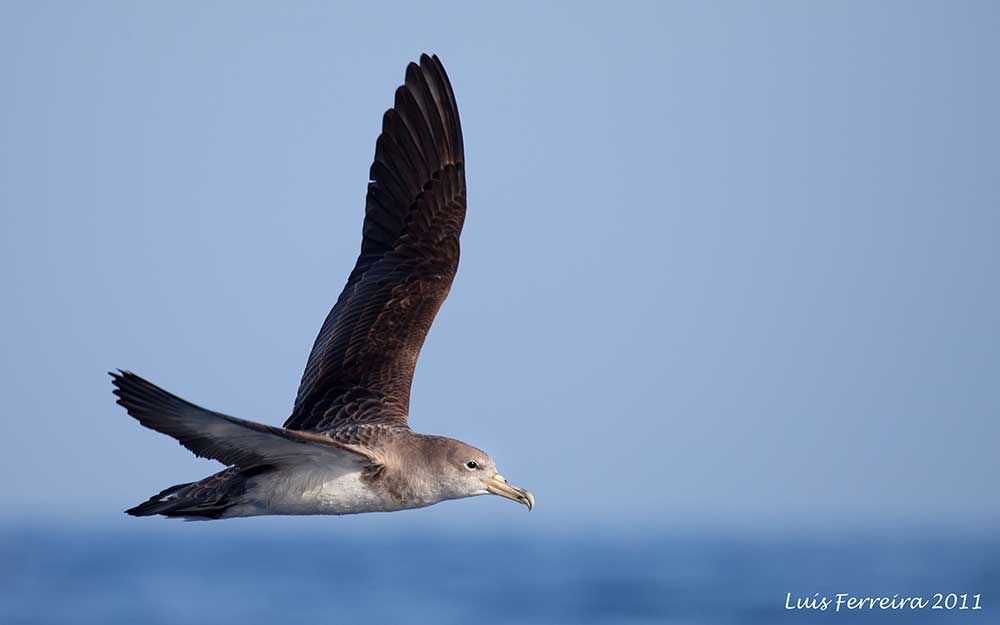 Seabirds can fly for many days and nights across featureless oceans to their preferred feeding locations and then fly back to their nests without getting lost. How they do this has long been a mystery. Now through a careful analysis of their flight patterns, researchers have shown that seabirds are following their noses and navigate using an “odour map” – a mental patchwork picture of local odours. It now seems likely that such maps are common place in the animal kingdom having a role in movements like migrations and finding food.
Seabirds can fly for many days and nights across featureless oceans to their preferred feeding locations and then fly back to their nests without getting lost. How they do this has long been a mystery. Now through a careful analysis of their flight patterns, researchers have shown that seabirds are following their noses and navigate using an “odour map” – a mental patchwork picture of local odours. It now seems likely that such maps are common place in the animal kingdom having a role in movements like migrations and finding food.
LÉVY FLIGHT
Correlated random walks are the dominant conceptual framework for the modelling of animal movement patterns. They are founded on ‘Brownian’ motion; an erratic random motion first observed in pollen grains by Robert Brown back in 1828 and later explained by Einstein (1905) in his most cited paper.
Brownian walks comprise similar sized steps that have length which are typically but not necessarily exponentially distributed. Turning angles are randomly orientated between 0 and 360 degrees.
A different movement strategy was first described by Paul Lévy (1937) and is called a ‘Levy flight’
A Levy flight comprise clusters of short step lengths with longer movements between them. This pattern is eventually repeated across all scales with the resultant clusters creating fractal patterns that have no characteristic scale. Levy flights can be advantageous when searching ‘blindly’ without knowledge of target locations and this may result in selection pressures for them.
Step-lengths in a Levy flight are power-law distributed:
p(l)≈l-µ
where p(l) denotes the frequency distribution of step length l and where the ‘Lévy exponent’ μ lies between 1 and 3. When μ lies in this range the characteristic size of a step <l2>1/2, diverges over time so that there is no typical step-length. When μ ≥ 3 step-lengths have a well-defined characteristic length, and movement patterns are effectively Brownian.
 ARE ACTUAL ANIMALS LÉVY WALKERS?
ARE ACTUAL ANIMALS LÉVY WALKERS?
This question, apparently simple, has been hotly contested: one group of scientists, heralded by Gandhi Viswanathan was convinced that Lévy walks were performed by animals, while others, following Andy Edwards are convinced that the observations of Lévy walks in nature were only the unfortunate by-product of inappropriate statistical analyses.
After 8 years from their joint seminal publication in 2007 showing how many errors may be made when analyzing animals’ movement, Lévy walks have now been firmly demonstrated in a range of different organisms:
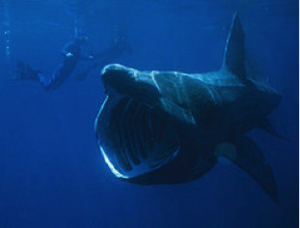 Marine predators link, link Marine predators link, link |
 Honeybees link, link Honeybees link, link |
 Cells and bacteria Cells and bacteria |
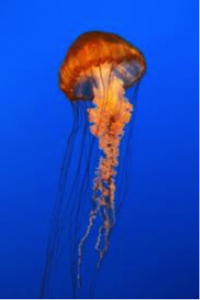 Jellyfishes Jellyfishes |
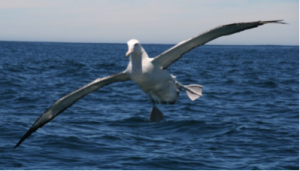 Wandering albatrosses link, link Wandering albatrosses link, link |
 Hunters/gatherers Hunters/gatherers |
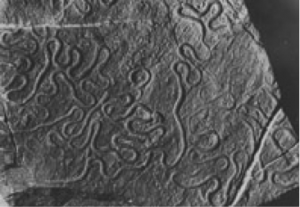 Extinct organisms Extinct organisms |
The theory recently developed by Gandhi Viswanathan in his book The Physics of Foraging: An Introduction to Random Searches and Biological Encounters develops the paradigm of Lévy flight foraging hypothesis. Accordingly, a forager should exhibit a μ = 2, which maximizes search efficiency.
However many examples of Lévy walks do not fit well this prediction since estimated value of μ are typically < 2 suggesting that trajectories are less meandering than expected. How can these anomalies be explained? In science, few anomalies can be accommodated by ad hoc hypotheses but many examples challenge the established paradigm.
The question is now whether all Lévy walks we observe in nature are determined by a form of optimal search or whether there are other mechanisms able to produce Lévy walks? This line of investigation has been led by Andy Reynolds. The general idea behind it is that interactions between animal movements and environment (though in a very broad sense) may result in animals performing Lévy walks without any internal neurological machinery, the so-called “fractal clock”.
AVIAN OLFACTORY NAVIGATION
The controversy about Lévy flights strongly impacts on another, sometime acrimonious, scientific controversy drifting in the scientific literature since more than 40 years: how birds are able to locate their home after flying hundreds or even thousands of kilometers? This is called the CONTROVERSY OF AVIAN OLFACTORY NAVIGATION (for; against) and is subject to scientific scrutiny since the time Gustave Kramer (1951) discovered that starlings use a sun compass with chronometric compensation, to take account of the apparent movement of the sun in the sky. Before this study, bird flights were mostly poesy and spell
| At length did cross an Albatross, thorough the fog it came; as if it had been a Christian soul, we hailed it in God’s name.The Rime of the Ancient Mariner(Samuel Taylor Coleridge) |
 An Etruscan haruspex (priest) dancing with birds. In the antiquity, these haruspices were famous for being able to interpretethe flight of birds. An Etruscan haruspex (priest) dancing with birds. In the antiquity, these haruspices were famous for being able to interpretethe flight of birds. |
THE THEORY
An example among hundreds of the extraordinary navigation capacity of birds is given by the shearwaters we studied
 |
|
The term true navigation is frequently used for goal-related orientation towards a given position on earth, usually a home site, towards which no direct sensory contact is available at the current position of an animal. In its strictest sense, the term is only applied if not even familiar landmarks surrounding the goal can be recognized, or are used, which potentially can guide to the goal. Such guidance by familiar landmarks is often called piloting (Walraff 2005). |
What methods do these birds use for coming back to their colony and to their nest (so called homing) after fliying many hundreds of kilometers away in an apparently featureless ocean? Floriano Papi and coworkers (1971) and Hans Walraff (2005) pointed out that an olfactory map is at work at least in the case of homing pigeons. Odours dispersing in atmospheric turbulence cannot be seen, but if they could they would look like a complex patchwork of concentrations varying in both space and time.
 |
 |
| Olfactory map at work: by previous experience the bird are able to associate a “boquet of odors” to winds arriving from different directions to the colony. In this example the yellow color comes from North and the blue odor from east. A bird released in S may be able (dark colors) or not (light colors) to detect the odor. If it detects the east odor it moves westward to attain the colony, if it detects the north odor it moves southward, if not it reorientates randomly. This sequence of events carries the bird in the vicinity of the colony (red dot). We assume, according to the work made on pigeons, that near the colonies different cues (e.g. landmarks or chemiotaxis) are used. |
Sometimes concentrations will fall below the threshold for detection. Sometimes they will rise above it. General principles dictate that the durations of these episodes are power-law distributed, which means that very long durations are a common occurrence.
Birds relying on these odours for navigation will therefore be with their map only some of time. When they are they can head directly for home. When they are not they have to cast around to relocate the odour. The lengths of the flight-segments will be power-law distributed. This is the hallmark of a “Levy flight”.
Mathematical modelling predicts a specific form for the step length distribution of birds using olfactory navigation (an exponentially truncated Lévy distribution) and a μ = 3/2.
EXPERIMENTS
We investigated 210 nesting shearwaters from 7 colonies of three different species: Cory’s shearwaters, Calonectris borealis, North Atlantic Ocean, Scopoli’s shearwaters, C. diomedea Mediterranean Sea, and Cape Verde shearwaters, C. edwardsii, Central Atlantic Ocean).
These birds breed in colonies and dad and mammie take turns to incubate the egg and search for food moving towards upheaving areas on the continental shelf.
We fitted animals with small GPS loggers to track them during foraging excursions
RESULTS
From this interdisciplinary cooperative effort of research a number of interesting new results emerge (paper link here) that:
| Tip 1. We showed that most of the studied birds perform Lévy flights. This evidence confirms previous reliable results that Lévy movements occur frequently under natural conditions. Thus the original controversy is now settled but during this, sometime painful (link), process a huge improvement of methods and awareness has been obtained.
Despite previous attempt to investigate avian navigation and animal paths this is first time we are able to connect two previously separated highly-relevant field of research. The essence of the scientific endeavor. |
| Tip 2. Despite previous attempt to connect avian navigation and animal paths recorded in the field this is first time we are able to connect two previously separated highly-relevant field of research. The essence of the scientific endeavor is finding more general and possibly simpler explanations of the natural processes. This does not detract from the Lévy flight foraging hypothesis, in fact, it adds to the theory by providing a stronger and more compelling case for the occurrence of Lévy walks. It dispenses with concerns about the theoretical arguments in support of the Lévy flight foraging hypothesis and so may lead to a wider acceptance of Lévy walks as models of movement pattern data (link). |
| Tip 3. Simple descriptions and good statistical fitting of Lévy distributions are not enough to satiate our curiosity: we want to understand why and how these patterns arise. What genuinely new insights have been gained by having found a robust, mechanistically supported, and in-all-other-ways superb power law? We believe that such insights are very rare (link). |
| Tip 4. Here is one of such insight since we demonstrated that an exponentially truncated Lévy flights with µ=3/2 are the hallmark of olfactory navigation. This may put an end to the Avian Navigation Controversy as well, since a large number of wild birds make use of olfactory for navigation and we put into ornithologists’ hand the tools to detect olfactory navigation in any bird large enough to carry a high-resolution GPS logger. |
THE TEAM
The research was performed through a cooperation among Italian, Portuguese and British scientists.
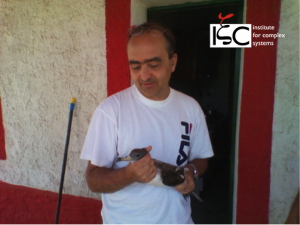
Stefano Focardi of the Istituto Sistemi Complessi of Consiglio Nazionale delle ricerche at Linosa with a distressed shearwater later released at the colony |
|
Andy Reynolds at the Rothamsted Research is going to develop the theory of olfactory navigation
|
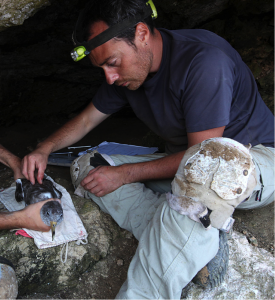
Jacopo G. Cecere of ISPRA tagging a Scopoli’s shearwater (Photo by Eugenio Manghi)
|
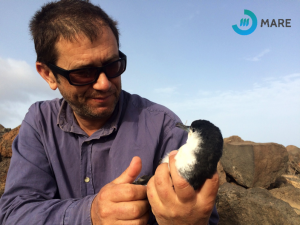
Jaime Ramso of MARE with a little shearwater on Razo Islet
|

Vitor Paiva of MARE with a Cory’s shearwater at Selvagem Gran
|
LÉVY 2.0
Movement is crucial for life and as a result has been studied intensively. Until recently this understanding was founded, almost exclusively, on Einstein’s theory of random walks. But many researchers are now reporting that a wide variety of organisms from single cells to humans perform Lévy walks – a complex form of movement pattern with strange fractal properties that seem alien to biology.
The revolution was ushered in 21 years old after it was reported that wandering albatrosses roam the skies in ways that Paul Lévy – the mathematician after whom Lévy walks are named – would have appreciated. This led to an explosion of interest in Lévy walks. The new study shows these studies had only caught of a glimpse of the Lévy world which is much richer than previously imagined.The authors studied close relatives of the wandering albatross – Cory’s shearwater (Calonectris borealis) in the North Atlantic Ocean and Scopoli’s shearwater (C. diomedea) in the Mediterranean sea – and found that all of the birds’ movements, flying, floating and diving are Lévy.
Armed with this knowledge we can now predict when the birds will take to the skies, how long they will remain airborne and when they dive back into the water.
Our observations could take Lévy patterns as models of animal behaviour to a new level by going beyond the characterisation of spatial movements to characterise how different behaviours are interwoven throughout daily animal life.
This opens up a new chapter in the Lévy story, Lévy 2.0, with the promise of understanding and predicting diverse animal behaviours.
For more information read the paper

 Cory’s shearwater, Calonectris borealis off Selvagem Grande (Selvagens archipelago)
Cory’s shearwater, Calonectris borealis off Selvagem Grande (Selvagens archipelago)




